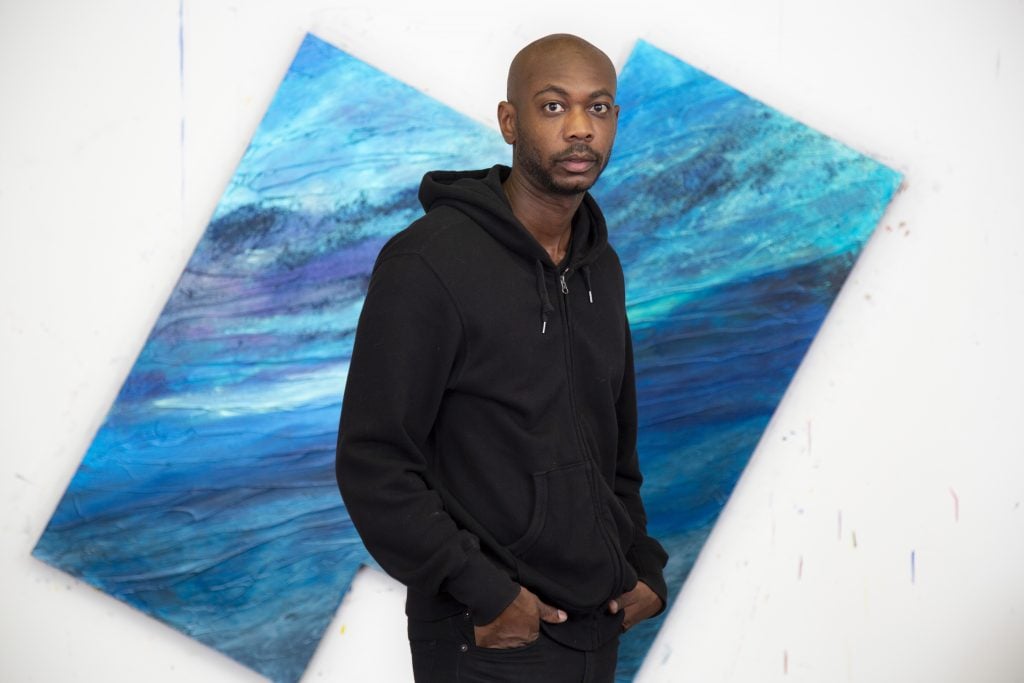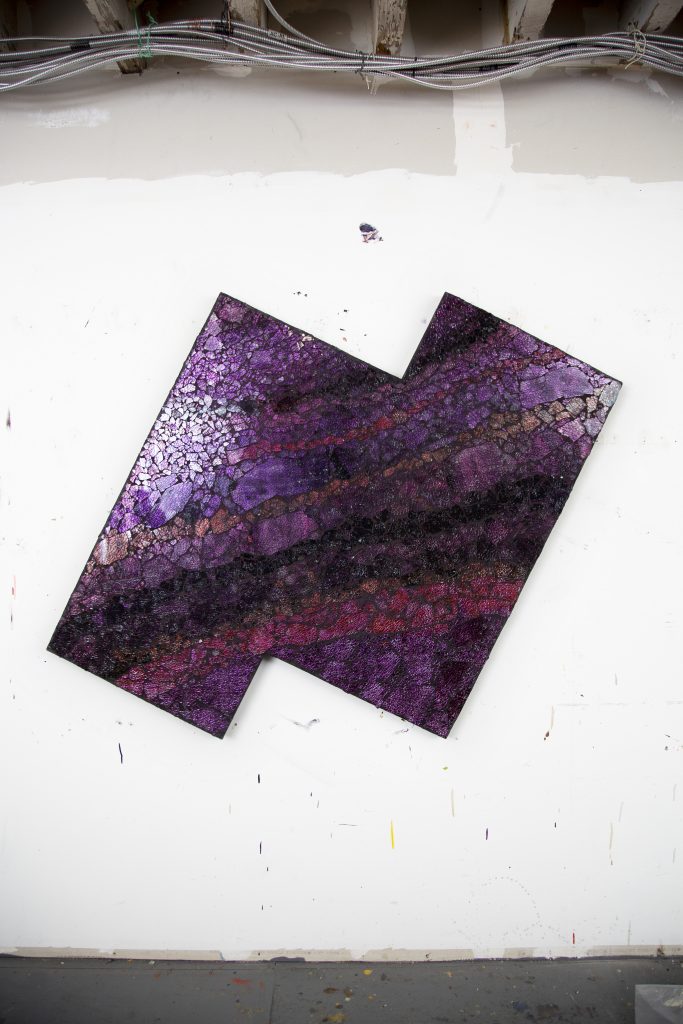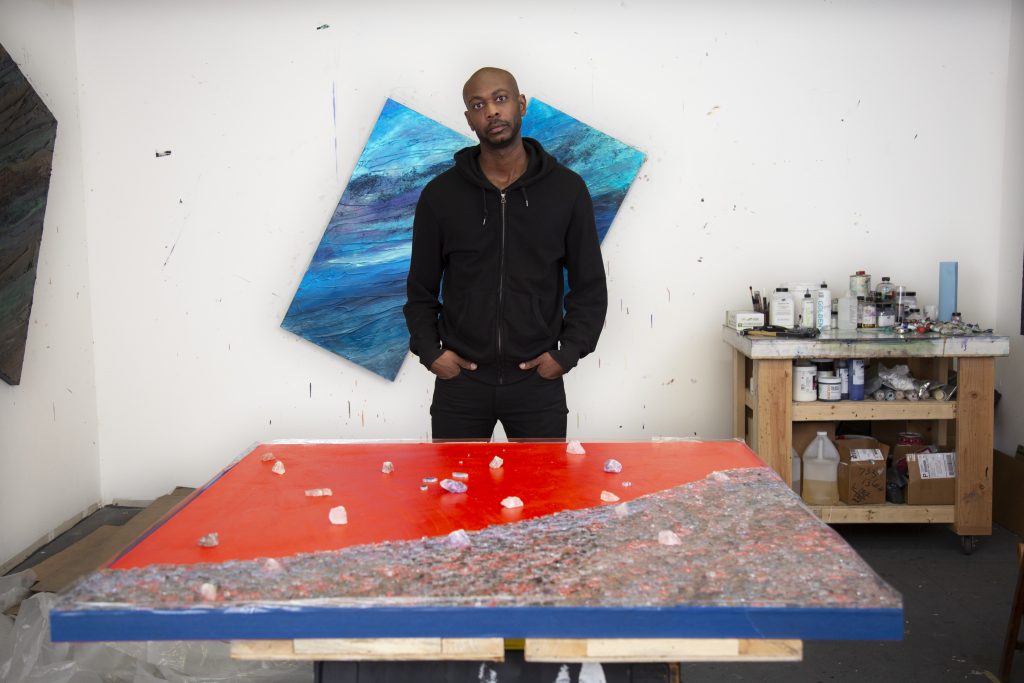Art World
Studio Visit: Artist Alteronce Gumby on His Weekly MoMA Visits, and Why Seeing Great Art is Like Reading a Book
The artist is currently preparing for a two-part exhibition at Charles Moffett and False Flag in New York.

The artist is currently preparing for a two-part exhibition at Charles Moffett and False Flag in New York.

Katie White

Alteronce Gumby spends his days in his Bronx studio engaged in an intricate process of setting small pieces of broken glass into his jewel-like abstract paintings. Sometimes shaped like plinths or zigzags, his acrylic-and-glass works seem to hint at Minimalism’s legacy. The glittering reflections of their surfaces, meanwhile, conjure up the seemingly conflicting images of Byzantine mosaics and shattered storefront windows and car windshields at once.
Currently, Gumby is preparing for a two-part exhibition, “Somewhere Under the Rainbow, The Sky is Blue and What Am I”, opening in March at Charles Moffett Gallery in Manhattan and at False Flag in Long Island City. The first monograph of Gumby’s work will be published coinciding with the show with contributions from Gagosian director and critic Antwaun Sargent and Guggenheim curator Ashley James.
We caught up with the artist to talk about his weekly sojourn to MoMA, how Howardena Pindell’s use of materials inspires him, and much more.
What are the most indispensable items in your studio and why?
My studio wouldn’t feel the same without my Nkisi Nkondi (power figure) who I call Hakeem. It was gifted to me by a family member. He keeps the bad spirits and negative energy out of the studio.
Is there a picture you can send of your work in progress?

Photography by Elizabeth Brooks. Courtesy of Charles Moffett Gallery.
What is the studio task on your agenda tomorrow that you are most looking forward to?
My studio tasks are usually the same every day. I go to the studio and get as much done as possible. My current process involves setting small pieces of broken glass in my paintings. This is a very time-consuming and laborious task, but I really enjoy it and usually get anxious when I get close to finishing a new painting. I can’t wait to get it up on the wall to study it, criticize it, hate it, and love it. All in that order.
What kind of atmosphere do you prefer when you work? Do you listen to music or podcasts, or do you prefer silence? Why?
I’m a big music guy. I love walking into my studio on Monday morning and playing my “discover weekly” playlist on Spotify, seeing what new music and vibes are in store for me this week. Over the quarantine, my studio building has been extremely quiet and I have found myself working in silence more these days. Living and working in New York City, there’s always sound being made. I’ve been trying to focus my attention and intention for the day through a daily meditation practice. Working in silence throughout the day has allowed me to focus more on what’s happening in the moment, in the paintings, and making clear decisions on what I want the work to do or feel.
What trait do you most admire in a work of art? What trait do you most despise?
I like art that has a delayed read to it. Let me explain that. I see a painting that I like and there’s something in the work that holds my attention longer than 30 seconds or two minutes. I’m drawn to works that were given a lot of attention to details. The devil is in the details. It’s in the color composition or orientation of the work or the clever use of contrasting materials that look or feel very seamless. It’s like a visual language that can be read through the materials, where idea, material, and concept come together—there’s fluidity between object and idea and I think the artist has to be very attentive to the materials and the way materials are composed in artwork to make the idea come forward.
When I see a work that I admire, it’s like I’m watching a good movie or reading a good book. That’s the feeling that keeps me engaged in a painting and keeps me looking. This comes together in the attention to detail. And that thing, the delayed read, makes the work so much more interesting for me. I leave feeling like I found some hidden treasure that no one else can see. It’s kind of like a magic trick. The artwork is taking you through the song and dance, and then the big reveal happens.
On the contrary, I dislike artwork that lacks intention. I can usually pick that up from one glance at an object. You’re asking yourself, ”Why is this here?” and it’s probably asking itself the same thing.
What snack food could your studio not function without?
I’m not a big snacker in the studio. But water is life. So I usually have a water bottle or two on standby.

Photography by Elizabeth Brooks. Courtesy of Charles Moffett Gallery.
Who are your favorite artists, curators, or other thinkers to follow on social media right now?
I’m trying to reduce my social media intake at the moment. But when I am on Instagram I follow the @blackartlibrary pretty closely. I’m an avid book collector and they’re always posting books I’ve never seen before or knew existed. I like checking out Ebony Haynes’s posts on Instagram. She started The FREE Black Art Sessions during the pandemic which give free advice to POCs thinking about getting involved in the art world. This is one of the dopest things I’ve ever seen done by someone in her position. I follow the Breakfast Club and Shaun King to see what’s buzzing right now in the black community. I also check out @ryandaviscomedy, @kenstarrrz, @nbcsnl for laughs.
When you feel stuck in the studio, what do you do to get un-stuck?
I leave! I drop whatever I’m doing and go for a walk. That walk usually leads me right into a museum or art gallery. I go see art at least once a week. At the beginning of 2020, I got an artist membership to MoMA. You can catch me there at least once a week studying a painting in the collection. I think it’s important for a visual artist to be constantly looking at art. Sometimes I turn to my collection of monographs and exhibition catalogues or the internet if something I want to see isn’t on view in the city.
What is the last exhibition you saw (virtual or otherwise) that made an impression on you?
Howardena Pindell’s exhibition “Rope, Fire, Water” at the Shed. She really raised the bar for me materially. Looking at her work, I see a really strong evolution of the hole punch material. Materials hold memories for her and I think that’s where the future of abstraction is going. It’s not just about using non-objective materials. Artists who followed Rauschenberg and Johns use materials that mean something to them. It’s more than paint or discarded materials, but rather taking materials from their personal histories and signifiers from their community that’s infused in the work. I think that makes the work that much more powerful. I also liked how Pindell used abstraction to address social justice and inequality issues in America in a very visceral way.